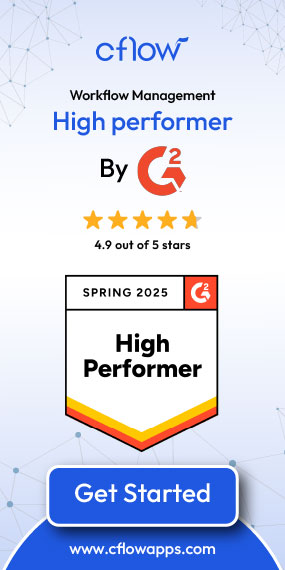- Cflow
- IT Budget Allocation Automation
IT Budget Allocation Automation

Clow Team

IT budget allocation is a critical planning process for aligning technology spending with business goals. Manual spreadsheets and email-based approvals often result in misallocations, missed deadlines, and lack of transparency. Recent reports show that 62% of IT projects exceed budget due to poor planning and visibility.
Without automation, finance teams and IT leadership face difficulties tracking budget requests, verifying justifications, and ensuring policy compliance. This guide walks you through exactly how Cflow automates IT Budget Allocation from request submission to executive approval.
What Is IT Budget Allocation Process?
The IT Budget Allocation Process determines how annual or quarterly funds are distributed across technology initiatives, departments, or vendor contracts. It includes gathering allocation requests, validating business cases, routing approvals, and monitoring budget usage.
Effective IT budgeting ensures capital is spent on strategic and operational needs, from software upgrades to cloud subscriptions. Automated workflows help prioritize initiatives, prevent overspending, and provide traceability. Industry research confirms automated IT budget systems reduce budget errors by 55% and increase forecasting accuracy by 40%.
Why IT Budget Allocation Automation Matters for Organizations?
Financial Governance
Alignment to Strategy
Audit Readiness
Transparency
Efficiency
Key Benefits of Automating IT Budget Allocation with Cflow
Centralized Request Portal: Cflow provides a unified digital form where IT and finance teams can submit and track budget requests. This eliminates reliance on disconnected spreadsheets and emails. Stakeholders collaborate within a centralized portal, improving visibility and reducing confusion. Real-time tracking helps speed up allocation and approval cycles.
Business Case Attachments: Each budget request can include attached ROI analyses, project justifications, and cost breakdowns. These documents stay embedded in the workflow, making evaluations faster and more thorough. No need to chase down supporting files separately. Approvers get all the information they need upfront.
Multi-Stage Approval Routing: Cflow dynamically routes requests based on department, amount, or strategic need. Smaller requests are directed to department heads, while larger allocations escalate to CFOs or CIOs. Each decision is logged to maintain traceability. This ensures the right people review the right budgets on time.
Real-Time Tracking & Dashboards: Visual dashboards display pending, approved, and available budgets in real time. Finance teams can quickly forecast and adjust spending based on accurate data. Departments monitor their own allocations without delay. It brings much-needed transparency and agility to budgeting.
Role-Based Visibility: Cflow restricts access so department users only see their own requests, while finance and executives have complete visibility. This protects sensitive data and simplifies user experience. It also enforces compliance by ensuring only authorized personnel can act on or view specific budgets.
Auto-Calculated Totals: As users input figures, Cflow automatically calculates totals by quarter, department, or expense category. This eliminates math errors and speeds up budget validation. Approvers immediately see how new requests affect the overall cap. It enforces financial discipline without external tools.
Integration Friendly: Cflow integrates with ERPs, accounting tools, and spreadsheets to sync approved budgets. This removes the need for duplicate entries and improves consistency. Finance teams gain a real-time connection between planned and actuals. It streamlines reporting and financial governance.
Get the best value for money with Cflow
User Roles & Permissions
Department Head (Initiator)
- Responsibilities: Submits IT budget allocation request, provides justification, selects category.
- Cflow Permission Level: Submit Form.
- Mapping: “Business Team.”
IT Director
- Responsibilities: Validates technical feasibility and alignment with IT strategy.
- Cflow Permission Level: Approve/Reject.
- Mapping: “IT Group.”
Finance Reviewer
- Responsibilities: Reviews budget availability, checks compliance with cost policies.
- Cflow Permission Level: Approve/Reject.
- Mapping: “Finance Team.”
CIO or CFO (Final Approver)
- Responsibilities: Conduct security risk analysis, validate compliance requirements, and flag potential policy violations.
- Cflow Permission Level: Approve/Reject.
- Mapping: “Security Team” group.
Discover why teams choose Cflow
Form Design & Field Definitions

Field Label: Budget Request ID
- Type: Autonumber
- Auto-Populate: Generated on submission.
Field Label: Requesting Department
- Type: Dropdown
- Logic/Rules: Mandatory field linked to org unit.
Field Label: Budget Category
- Type: Dropdown
- Logic/Rules: Mandatory.
Field Label: Requested Amount
- Type: Currency Field
- Logic/Rules: Required, validates against department threshold.
Field Label: Justification / Business Case
- Type: Text Area
- Logic/Rules: Required if budget exceeds defined limit.
Field Label: Supporting Documents
- Type: File Upload
- Logic/Rules: Mandatory for new project budgets.
Field Label: Budget Quarter / Period
- Type: Dropdown (Q1, Q2, Q3, Q4, Annual)
- Logic/Rules: Required.
Field Label: Total Budget After Allocation
- Type: Calculated Field
- Logic/Rules: Auto-updates based on department cap and new request.
Transform your Workflow with AI fusion
Approval Flow & Routing Logic

Submission → IT Director
- Status Name: Pending IT Review
- Notification Template: “IT budget request submitted—please validate technical alignment.”
- On Approve: Move to Finance Reviewer.
- On Reject: Return to Department Head.
- Escalation: Notify IT VP in 1 day.
IT Director → Finance Reviewer
- Status Name: Pending Finance Review
- Notification Template: “Please review requested amount and confirm compliance.”
- On Approve: Move to CIO/CFO.
- On Reject: Return to IT Director.
- Escalation: Alert Finance Controller after 24 hours.
Finance Reviewer → CIO/CFO
- Status Name: Pending Final Approval
- Notification Template: “Final approval needed for IT budget allocation.”
- On Approve: Mark as Allocated.
- On Reject: Return to Finance Reviewer.
- Escalation: Escalate to CEO office.
Transform your AI-powered approvals
Implementation Steps in Cflow
Create a new workflow
Design the form
Set up User Roles/Groups
Build the process flow diagram
Configure notifications
Set conditional logic
Save and publish workflow
Test with a sample request
Adjust logic if needed
Go live
Example Journey: Cloud Infrastructure Budget Q2
FAQ's
Unleash the full potential of your AI-powered Workflow

